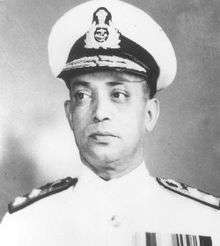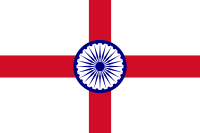Ram Dass Katari
| Admiral Ram Dass Katari PVSM, AVSM | |
|---|---|
 | |
| Born |
8 October 1911 Chingleput, Madras Presidency, British Raj (now in Tamil Nadu, India) |
| Died |
21 January 1983 (aged 71) Secunderabad, Andhra Pradesh, India |
| Allegiance |
|
| Service/ |
|
| Years of service | 1927–1962 |
| Rank |
|
| Commands held |
Chief of the Naval Staff Indian Fleet INS Rajput (D141) HMIS Kistna (U46) HMIS Cauvery (U10) |
| Battles/wars |
World War II Liberation of Goa |
| Other work |
Ambassador to Burma Chairman, APSRTC Author, A Sailor Remembers |
Admiral Ram Dass Katari (8 October 1911 - 21 January 1983) was an Indian Navy officer who served as the 3rd Chief of the Naval Staff from 22 April 1958 to 4 June 1962. He was the first Indian to hold the office and succeeded the last British officer to the post, Vice Admiral Sir Stephen Hope Carlill. He led the Indian Navy in the conflict during the liberation of Goa against the Portuguese Navy.
Early life
Adm R D Katari was born in Chingleput in Madras Presidency on October 8, 1911. He spent most of his childhood and youth in Hyderabad. He was educated at Mahbub College High School and at Nizam College in Hyderabad.
Naval career
After graduation, Katari was in the first batch of Indian cadet-entry officers to join TS Dufferin on its establishment in 1927. He topped the entrance examination. He finished the course earning the Viceroy's Gold Medal. Later, he was the first graduate of TS Dufferin to serve on its Governing Board.
On 23 September 1939, three weeks after the start of World War II, Katari received a temporary commission as a probationary Sub Lieutenant in the Royal Indian Navy Volunteer Reserve. He was assigned to the auxiliary patrol vessel HMIS Sandoway as its most junior officer on 11 May 1940.[1] Promoted to temporary lieutenant on 23 September 1940, he was subsequently assigned to HMIS Dalhousie, the naval gunnery school in Bombay.[2] On 9 April 1943, he was posted to Karachi and assigned to HMIS Bahadur, the Boys' Training Establishment for the RIN.[3]
Katari served in surface fleets of the Atlantic and Indian Oceans. He specialized in anti-submarine warfare. Later, he also served as an instructor at the Anti-Submarine Warfare School, and was promoted to acting lieutenant-commander on 30 September 1944.[4] At the end of the war, as a Lieutenant-Commander, he was appointed the Commanding officer of HMIS Cauvery (U10) and led the mine clearance operations in the Andaman & Nicobar Islands.
Upon the Independence of India, he held the rank of Commander and was the Commanding officer of HMIS Kistna (U46). He led the defence operations off the Kathiawar coast during the integration of Junagadh. From July 1948 to early 1949, he was the Executive Officer on board the cruiser, INS Delhi (1948), with Lt S M Nanda as his First Lieutenant.
In December 1948, he was promoted to acting Captain. In February 1949, he was appointed the Chief of Personnel at Naval Headquarters (NHQ), and was promoted to the substantive rank of captain on 31 December 1949.[5]
In December 1951, he was the Commanding officer of the Indian Navy's Destroyer Squadron as well as the lead destroyer of the squadron, INS Rajput (D141).
In 1953, he underwent a staff course at the Imperial Defence College, London. Upon his return in early 1954, he was appointed the Deputy Chief of the Naval Staff (DCNS) and promoted to Commodore.
Katari was promoted to acting Rear Admiral on 12 March 1956.[6] On 2 October 1956, he was confirmed as a substantive rear admiral and became the first Indian officer to be appointed the Flag Officer Commanding of the Fleet.[7]
On 22 April 1958, he became the first Indian officer to be appointed Chief of the Naval Staff (CNS). As CNS, he designed the framework for India's strategy for managing maritime security issues. During his tenure, the Indian Navy underwent a consolidation of its acquisitions, and established plans for its future growth. It also instituted improvements to training and operational effectiveness programs. India's first aircraft-carrier, INS Vikrant, was commissioned during his tenure.
As CNS, he led the naval operations during the liberation of Goa from Portuguese rule in December 1961.
He retired as CNS on 4 June 1962.[8] He relinquished the post of CNS as a vice-admiral, then the highest rank in the Indian Navy.
Later life
Katari served as the Chairman of Andhra Pradesh State Road Transport Corporation (APSRTC) between December 1962 and May 1964. In 1964 he was appointed India's Ambassador to Burma, where he served for over five years.[9] He was the first setter of The Hindu Crossword and compiled the daily puzzles till his demise.[10] [11] He also authored a memoir of the formative years of the Indian Navy during his service, A Sailor Remembers.
In 1968, the post of CNS was upgraded to the rank of full admiral, and on 21 October 1980, he and Bhaskar Sadashiv Soman, his successor as CNS, were promoted to the honorary rank of full Admiral on the retired list by President Neelam Sanjiva Reddy.[12] Admiral Katari died at Secunderabad on 21 January 1983, aged 71.[13] The Katari Memorial Hall at A/21, Sainikpuri, near Secunderabad, was dedicated to the memory of ADM Katari on the event of his birth centenary on October 8, 2011.[14]
References
- ↑ The Navy List: December 1941. HM Stationery Office. 1941. p. 1061.
- ↑ The Navy List: December 1942. HM Stationery Office. 1942. p. 1184.
- ↑ The Navy List: April 1944. HM Stationery Office. 1944. p. 3030.
- ↑ The Navy List: July 1945. HM Stationery Office. 1945. p. 2106.
- ↑ "Part I-Section 4: Ministry of Defence (Navy Branch)". The Gazette of India. 14 January 1950. p. 93.
- ↑ "Part I-Section 4: Ministry of Defence (Navy Branch)". The Gazette of India. 24 November 1956. p. 236.
- ↑ "Part I-Section 4: Ministry of Defence (Navy Branch)". The Gazette of India. 2 March 1957. p. 55.
- ↑ "Vice Admiral Ram Dass Katari". Information Resource Facilitation Centre, Indian Navy. Retrieved 2011-10-19.
- ↑ "People". Andhra Pradesh State Road Transport Corporation. Retrieved 2011-10-19.
- ↑ "Remembering Admiral Katari, the first crossword setter of The Hindu". Crossword Unclued, 8 October 2012.
- ↑ Ram Dass, Katari (1983). Sailor remembers. [S.l.]: Pub By Vi. ISBN 9780706920642.
- ↑ "Part I-Section 4: Ministry of Defence (Navy Branch)". The Gazette of India. 29 November 1980. p. 1360.
- ↑ "Deaths". The Times. 26 January 1983.
- ↑ "Inauguration of Katari Memorial heritage Hall at Sainikpuri Secunderabad". The Hyderabad Deccan. 2011-10-07. Retrieved 2011-10-19.
| Military offices | ||
|---|---|---|
| Preceded by Stephen Hope Carlill |
Chief of the Naval Staff 1958–1962 |
Succeeded by Bhaskar Sadashiv Soman |
